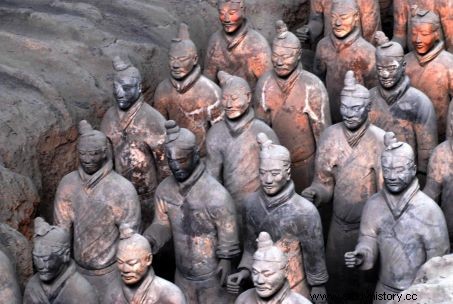The supposed protective treatment of the bronze weapons of the terracotta warriors of the mausoleum in Xi'an, China, considered to be the oldest known anti-rust technology, is not what was thought...

Detail of the hilt and blade of one of the terracotta army swords of Xi'an, China.
Sparkling like day one! After more than 2000 years buried in the ground, the bronze weapons of the famous army of 7000 clay soldiers of Qin Shi Huang Di (259-210 BC) – the unifying emperor of China - had been found, in 1974, in surprising conditions of preservation. So much so that archaeologists believed that these spearheads, swords, and some 40,000 arrowheads had been subject to special treatment in antiquity, a thin layer of chromium oxide (Cr) having been applied to metal parts. Be the first rust remover in history.
The ace ! Marcos Martinon-Torres, a specialist in ancient metals at the University of Cambridge (Great Britain) has just ruined this hypothesis after carrying out analyzes with his Chinese colleagues. Only insignificant traces of chrome were indeed found on 37 of the 464 weapons examined, whether swords or arrowheads. "In addition, they were exclusively located at the height of the wooden handles and poles “Explains the archaeologist, joined by Sciences et Avenir. This would be explained, according to the study published by the Anglo-Chinese team in the magazine Scientific Reports , simple contamination by migration. Significant amounts of chromium were actually contained in the lacquers used to coat the clay warriors. Because this army, as well as most of the organic materials (wood, bamboo) saved in the mausoleum of Xian, were covered with this protective film before being colored using precious mineral pigments.
Sparkling like day one! After more than 2000 years buried in the ground, the bronze weapons of the famous army of 7000 clay soldiers of Qin Shi Huang Di (259-210 BC) – the unifying emperor of China - had been found, in 1974, in surprising conditions of preservation. So much so that archaeologists believed that these spearheads, swords, and some 40,000 arrowheads had been subject to special treatment in antiquity, a thin layer of chromium oxide (Cr) having been applied to metal parts. Be the first rust remover in history.
The ace ! Marcos Martinon-Torres, a specialist in ancient metals at the University of Cambridge (Great Britain) has just ruined this hypothesis after carrying out analyzes with his Chinese colleagues. Only insignificant traces of chrome were indeed found on 37 of the 464 weapons examined, whether swords or arrowheads. "In addition, they were exclusively located at the height of the wooden handles and poles “Explains the archaeologist, joined by Sciences et Avenir. This would be explained, according to the study published by the Anglo-Chinese team in the magazine Scientific Reports , simple contamination by migration. Significant amounts of chromium were actually contained in the lacquers used to coat the clay warriors. Because this army, as well as most of the organic materials (wood, bamboo) saved in the mausoleum of Xian, were covered with this protective film before being colored using precious mineral pigments.

Elements of the clay army. ©Xie Zhengchina /AFP
How, then, to explain the exceptional state of preservation of the metals? The article puts forward a hypothesis, that of the chemical composition and characteristics of the soil. "A moderately alkaline pH and low organic matter content could be an explanation" , argue some researchers who themselves recognize that this is not enough. "We are going to investigate further. Because if chrome is now excluded, we still do not have a significant answer to explain the brilliance and the quality of the edges of these blades , continues Liu Xiuzhen, co-author of the publication:It could be metals with very high tin content, or even quenching techniques [metallurgical operations]not yet elucidated".
